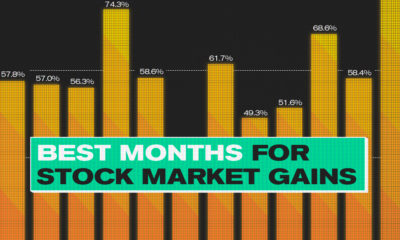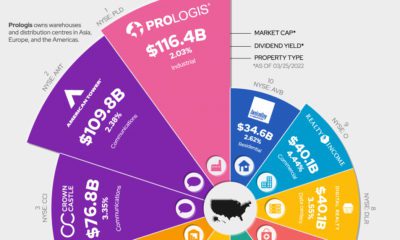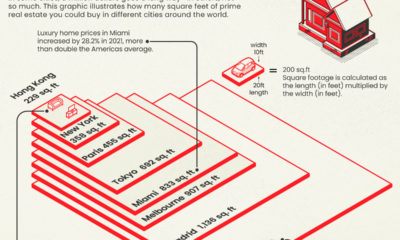Under the right circumstances, an innovation can scale and flourish. Within the financial realm, there is perhaps no better example of this than the introduction of exchange-traded funds (ETFs), a new financial technology that emerged out of the index investing phenomenon of the early 1990s. Since the establishment of the first U.S. ETF in 1993, the financial instrument has gained broad traction — and today, the ETF universe has an astonishing $5.75 trillion in assets under management (AUM), covering almost every niche imaginable.
Navigating the ETF Universe
Today’s data visualization comes to us from iShares by BlackRock, and it visualizes the wide scope of assets covered by the ETF universe. To start, let’s look at a macro breakdown of the “galaxies” that can be found in the universe: As you can see, equities are by far the largest galaxy in the ETF universe, making up 76.4% of all assets. These clusters likely comprise the ETFs you are most familiar with — for example, funds that track the S&P 500 index or foreign markets. That said, it’s worth noting that the fastest expanding galaxy is bond ETFs, tracking indices related to the debt issued by governments and corporations. The first bond ETFs were introduced in 2002, and since then the category has grown into a market that exceeds $1 trillion in AUM. Bond ETFs are expected to surpass the $2 trillion mark by 2024.
Everything Under the Sun
While the sheer scale of the ETF universe is captivating, it’s the variety that shows you how ubiquitous the instrument has become. Today, there are over 8,000 ETFs globally, covering nearly every asset class imaginable. Here are some of the lesser-known and more peculiar corners in the ETF universe: Thematic ETFs: Gaining popularity in recent years, thematic ETFs are built around long-term trends such as climate change or rapid urbanization. By having more tangible focus points, these funds can also appeal to younger generations of investors. Contrarian ETFs: In a healthy market, there can be a variety of different positions being taken by investors. Contrarian ETFs help to make this possible, allowing investors to bet against the “herd”. Factor-based ETFs: This approach uses a rules-based system for selecting investments in the fund portfolio, based on factors typically associated with higher returns such as value, small-caps, momentum, low volatility, quality, or yield. Global Macro ETFs: Some ETFs are designed to mimic strategies used by hedge fund managers. One example of such a strategy is global macro, which aims to analyze the macroeconomic environment, while taking corresponding long and short positions in various equity, fixed income, currency, commodities, and futures markets. Commodity ETFs: There are ETFs that track gold or oil, sometimes even storing physical inventories. Interestingly, however, there are commodity ETFs for even more obscure metals and agricultural products, such as zinc, lean hogs, tin, or cocoa beans. Whether your investments track popular market indices or you are more surgical about your portfolio exposure, the ETF universe is impressively vast — and it’s projected to keep expanding in size and diversity for years to come. on Last year, stock and bond returns tumbled after the Federal Reserve hiked interest rates at the fastest speed in 40 years. It was the first time in decades that both asset classes posted negative annual investment returns in tandem. Over four decades, this has happened 2.4% of the time across any 12-month rolling period. To look at how various stock and bond asset allocations have performed over history—and their broader correlations—the above graphic charts their best, worst, and average returns, using data from Vanguard.
How Has Asset Allocation Impacted Returns?
Based on data between 1926 and 2019, the table below looks at the spectrum of market returns of different asset allocations:
We can see that a portfolio made entirely of stocks returned 10.3% on average, the highest across all asset allocations. Of course, this came with wider return variance, hitting an annual low of -43% and a high of 54%.
A traditional 60/40 portfolio—which has lost its luster in recent years as low interest rates have led to lower bond returns—saw an average historical return of 8.8%. As interest rates have climbed in recent years, this may widen its appeal once again as bond returns may rise.
Meanwhile, a 100% bond portfolio averaged 5.3% in annual returns over the period. Bonds typically serve as a hedge against portfolio losses thanks to their typically negative historical correlation to stocks.
A Closer Look at Historical Correlations
To understand how 2022 was an outlier in terms of asset correlations we can look at the graphic below:
The last time stocks and bonds moved together in a negative direction was in 1969. At the time, inflation was accelerating and the Fed was hiking interest rates to cool rising costs. In fact, historically, when inflation surges, stocks and bonds have often moved in similar directions. Underscoring this divergence is real interest rate volatility. When real interest rates are a driving force in the market, as we have seen in the last year, it hurts both stock and bond returns. This is because higher interest rates can reduce the future cash flows of these investments. Adding another layer is the level of risk appetite among investors. When the economic outlook is uncertain and interest rate volatility is high, investors are more likely to take risk off their portfolios and demand higher returns for taking on higher risk. This can push down equity and bond prices. On the other hand, if the economic outlook is positive, investors may be willing to take on more risk, in turn potentially boosting equity prices.
Current Investment Returns in Context
Today, financial markets are seeing sharp swings as the ripple effects of higher interest rates are sinking in. For investors, historical data provides insight on long-term asset allocation trends. Over the last century, cycles of high interest rates have come and gone. Both equity and bond investment returns have been resilient for investors who stay the course.













